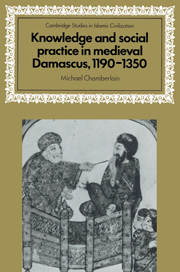Book contents
- Frontmatter
- Contents
- Preface
- List of abbreviations
- 1 Damascus and its surrounding region
- 2 Damascus in the thirteenth century
- Introduction
- 1 The acyān of Damascus, 590/1193–750/1350
- 2 Madrasas, the production of knowledge, and the reproduction of elites
- 3 Manṣabs and the logic of fitna
- 4 Social and cultural capital
- 5 Truth, error, and the struggle for social power
- Summary
- Bibliography
- Index
Summary
Published online by Cambridge University Press: 06 November 2009
- Frontmatter
- Contents
- Preface
- List of abbreviations
- 1 Damascus and its surrounding region
- 2 Damascus in the thirteenth century
- Introduction
- 1 The acyān of Damascus, 590/1193–750/1350
- 2 Madrasas, the production of knowledge, and the reproduction of elites
- 3 Manṣabs and the logic of fitna
- 4 Social and cultural capital
- 5 Truth, error, and the struggle for social power
- Summary
- Bibliography
- Index
Summary
“In an era of upheaval,” writes Charles Maier of a similarly resourceful elite, “it is continuity and stability that need explanation.” In this study I have tried to identify some of the practices by which the elite of a medieval Middle Eastern city acquired power, resources, and prestige, and reproduced their status in time. One of the principal aims of the study has been to question the often uncritical application to the medieval Middle East of the concepts and methods of European social history. The social history of structures, agencies, and formal processes and routines, constructed from original documents, appeared in Europe answering to particular European social imperatives. It was partly (though not entirely) through such mechanisms that individuals, lineages, and groups in Europe struggled for power, property, and prestige, and passed them on to their descendants. These historiographical practices have been well applied to societies such as Sung China where formal institutions and well-defined social bodies had roles that to Europeans were familiar or made sense. In the cases of Sung China and the Latin West, scholars have been able to identify (and identify with) a familiar principle of legitimate “order.” The transposition of either principle to the medieval Middle East works only by positing the continuous “corruption” of the order we have sought to find.
High medieval Syria, however, together with much of the medieval Middle East, was not a society of specialized institutions, state agencies, or of well-defined corporate bodies.
- Type
- Chapter
- Information
- Knowledge and Social Practice in Medieval Damascus, 1190–1350 , pp. 176 - 178Publisher: Cambridge University PressPrint publication year: 1995

